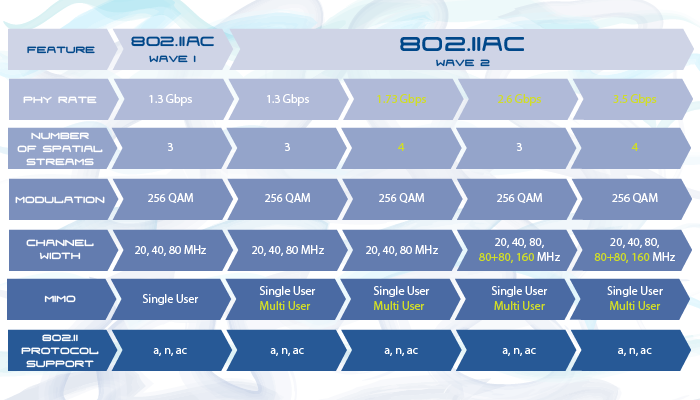The second phase of 802.11ac equipment, also referred to as Wave 2, is set to hit the shelves early next year and will undoubtedly give networks a performance boost that will force networks to invest in upgrades.
According to Tech Blogger Gina Narcisi, “Gigabit Ethernet edge switches can handle the flows produced by Wave 1 802.11ac, but Wave 2 will require new switches to handle faster traffic.” In addition, the second generation of the 802.11ac will create a market need for 2.5 and 5Gb Ethernet switches.
With a physical link rate of nearly 7Gbps, even 1GB Ethernet will no longer be able to support a network with several connected 802.11ac devices. This will force eager adopters to upgrade to 10Gb Ethernet or wait until the MBASE-T and NBASE-T alliances standardize 2.5 and 5G Ethernet specifications.
Wave 2 802.11ac equipment will prepare networks for the projected 212 billion wireless devices expected to connect to the internet by 2020.
Networks that want to benefit from a smaller performance boost without an additional investment in infrastructure upgrades might want to consider catching the first wave of 802.11ac.

Beamforming and MU-MIMO
To reach optimal speeds, instead of relying on an omnidirectional broadcasting signal, the second wave of 802.11ac access points will depend heavily on explicit beamforming to be able to support Multi-User MIMO (also known as Multi-Input and Multi-Output). In order to determine which direction to broadcast a signal, explicit beamforming requires both the transceiver and receiver to communicate with each to establish a strong signal path to form the beamform. Beamforming helps direct a transmission signal towards a specific location to strengthen the reception of a signal.
MU-MIMO relies on Spatial-Division Multiple Access (SDMA) “to allow multiple transmitters to send separate signals and multiple receivers to receive separate signals simultaneously in the same band”. This new ability to multitask within the 8 available spatial streams will make it possible to “serve multiple clients at the same time and support an increased number of VoIP calls, video streams, and other Jitter and Latency-sensitive applications.”
802.11ac can act as an overlay to an 802.11n network and will not necessarily be replacing 802.11n networks.
Will you be catching the first wave or second wave of 802.11? Leave us a comment below.
Follow us on Facebook and Twitter for the latest news in the Telco and computer networking news.


